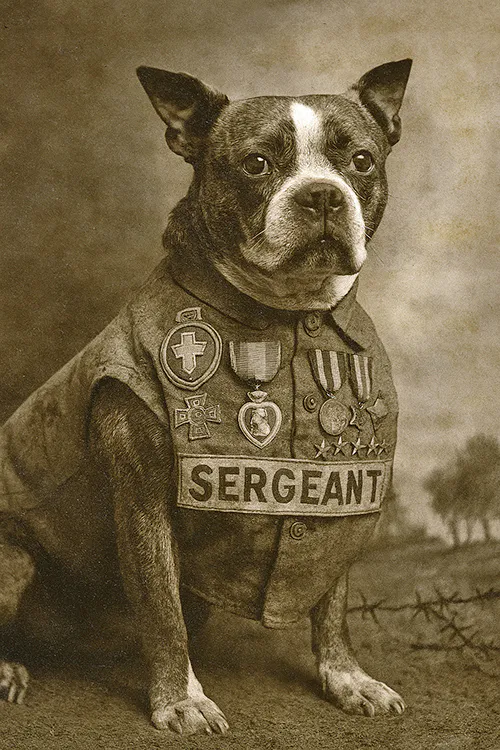
Sergeant Stubby was a stray Boston Terrier (probably; Boston Terrier was a new breed then, so he might have been something similar) who was found wandering the grounds of the Yale University campus in New Haven, Connecticut, in July 1917, where members of the 26th Yankee Division were training.
He learned their drills and even learned how to salute when the others did, by raising a paw to his head. When the division shipped out to Europe, Corporal James Robert Conroy (1892–1987) smuggled him onto the troop ship. Stubby was later discovered by Conroy's commanding officer, but Stubby saluted him and won him over. The commanding officer allowed Stubby to stay, and he became their official mascot when they deployed to the trenches of the World War I.
But Stubby’s story is far from over. His first injury was from mustard gas, which made him sensitive to the slightest trace of the gas: the next time there was a mustard gas attack early in the morning, he woke the soldiers so they could sound the alarm and get their masks on. On 20 April 1918, Stubby was injured during a grenade attack, receiving a large number of shrapnel pieces in his chest and leg. He was treated at a field hospital and, once well enough, he visited other wounded soldiers, boosting their morale. This probably contributed to his later talent for locating wounded men: he would listen for men calling out and then go to the location, barking until paramedics arrived or leading the lost soldiers back to the safety of the trenches. He even caught a German soldier near the Allied trenches and began to bark. The German ran, but Stubby bit him and tripped him up, keeping him detained until the US soldiers arrived.
Stubby was promoted to sergeant, and received numerous accolades and medals, including two Purple Hearts, and is one of the most decorated dogs of World War I. Robert Conroy and Stubby returned home in 1918 and over the next few years they met three presidents: Wilson, Coolidge and Harding.
Stubby died in his sleep on 16 March 1926, aged around 9 or 10. He was preserved by taxidermy and is part of the permanent collection of the Smithsonian Institution, where most of these details come from.
Public domain image courtesy of the Smithsonian Institution, National Museum of American History.


